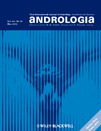Sequential analysis of sperm functional aspects involved in fertilisation: a pilot study
Summary
The development of diagnostic techniques in andrology as a second level of approach to the diagnosis of male factor infertility has enthused the focus of researchers on the development of a sequential diagnostic programme for these men. Semen samples of 78 men form couples undergoing in vitro fertilisation therapy were used in the study. The semen samples were used to test sperm functional aspects known to interfere with fertilisation. These tests included semen profile, DNA integrity, apoptosis, chromatin packaging, acridin orange staining, zona binding capacity, zona-induced acrosome reaction (AR). Results were correlated with fertilisation outcome. Statistical analyses of the recorded data were carried out using a logistic regression analysis model on all sperm functional tests. A negative and significant association with the fertilisation rates was recorded for DNA damage (r = −0.56; P ≤ 0.0005). A positive significant correlation was recorded between fertilisation rates and sperm with normal DNA (r = −0.57, P ≤ 0.0004), and zona-induced AR (r = 0.33, P ≤ 0.002). Diagnostic andrology can be regarded as a mandatory part of the male factor patient’s work-up schedule to assist clinicians with the most suitable therapeutic modality to follow.




